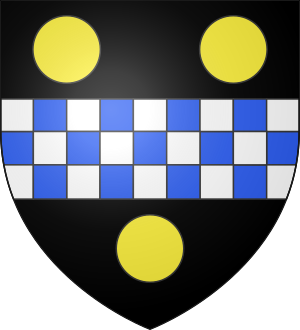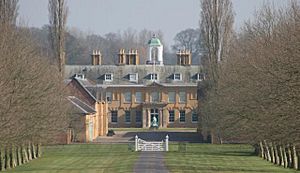William Pitt (courtier) facts for kids
Sir William Pitt (born 1559 – died 29 May 1636) was an important English politician and courtier. He lived in places like Old Palace Yard in Westminster, and had homes in Hartley Wespall and Stratfield Saye in Hampshire. He also owned land in Iwerne Stepleton in Dorset. Sir William Pitt served in the House of Commons, which is like a part of the government, between 1614 and 1625.
Who Was Sir William Pitt?
Sir William Pitt was the oldest son of John Pitt (who died in 1602). His father worked for Queen Elizabeth I as a Clerk of the Exchequer. The Exchequer was like the government's finance department, handling all the money. John Pitt was also a merchant from Blandford Forum in Dorset. Sir William's mother was Joan Swayne.
The Pitt family's coat of arms, which is like a special family symbol, shows a checkered pattern and three gold coins. This design was chosen because of their family's work with money in the Exchequer. In olden times, the Exchequer used a checkered cloth on a table to count and manage money.
Sir William Pitt had a younger brother named Thomas Pitt. From Thomas's family came some very famous people. One was his grandson, Thomas Pitt (1653–1726), who became very wealthy as President of Madras (a place in India). Another famous family member was William Pitt, 1st Earl of Chatham (1708–1778), often called "Pitt the Elder." He was Prime Minister of Great Britain twice! His son, William Pitt the Younger (1759–1806), also became Prime Minister.
Sir William's Career
Sir William Pitt held important jobs during the time of King James I. He was a comptroller of the household, which meant he managed the royal household's finances. He was also a main officer of the Exchequer, helping to manage the government's money.
He bought land and property in Hampshire, including the manor of Stratfield Turgis and property at Stratfield Saye.
In 1614, Sir William was chosen to be a member of parliament (MP) for a town called Wareham. He was knighted by the King on February 2, 1619, which meant he was given the title "Sir." He was re-elected as an MP for Wareham in 1621.
In 1624, he wanted his son, Edward Pitt, to also become an MP for Wareham. However, the mayor of the town disagreed. So, Edward became an MP for Poole instead. Sir William himself was re-elected as MP for Wareham in 1625. Around 1630, he made his home, Stratfield Saye House, even bigger.
Family Life
Sir William Pitt married Edith Cadbury. She was one of the daughters of Nicholas Cadbury from Arne, a village near Wareham in Dorset.
The church in Iwerne Stepleton still has a silver plate from 1638. It has the Pitt family's coat of arms combined with the Cadbury family's arms, showing their marriage.
Sir William and Edith had children, including:
- Edward Pitt (died 1643): He was their oldest son and inherited Stratfield Saye House. He also became an MP.
- William Pitt: Their younger son, who lived in Hartley Wespall.
Death and Burial
Sir William Pitt passed away at his home in Stratfield Saye when he was about 76 years old. His son, Edward, had a grand monument built for him in the local church.



